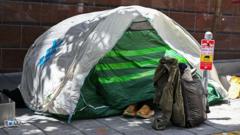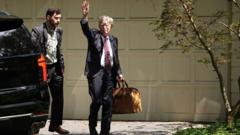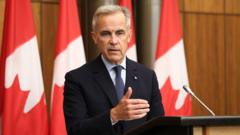**With rising homelessness in the U.S., Trump's enforcement strategy raises debates over effectiveness versus punitive measures, echoing San Francisco's tough approach.**
**Trump Takes a Page from San Francisco's Playbook in Tackling DC Homelessness**

**Trump Takes a Page from San Francisco's Playbook in Tackling DC Homelessness**
**President Trump implements aggressive homeless encampment clear-outs in Washington DC, mirroring San Francisco's controversial policies.**
In recent developments, Washington DC is adopting measures reminiscent of the controversial strategies employed by San Francisco in tackling its homelessness crisis. This shift comes as President Donald Trump has ordered federal agents to begin clearing homeless encampments in the capital, aligning with a nationwide trend of criminalizing sleeping outdoors. The approach, sparked by a significant Supreme Court ruling that upheld the legality of issuing citations to homeless individuals even without shelter, is reminiscent of San Francisco's aggressive tactics during the past year.
Under Governor Gavin Newsom, clear-outs of encampments became a priority in California, showcasing a notable transformation in areas plagued by visible poverty. While some local businesses and residents laud the efforts, others remain skeptical about the long-term effectiveness in resolving the underlying issues. Cities across the nation are increasingly facing the dual challenge of homelessness and its perception, which intensified during the COVID-19 pandemic, particularly in San Francisco where the disparity between tech wealth and street homelessness became glaringly evident.
As homelessness figures soared, both state and federal responses ramped up. San Francisco's initiatives, aimed at addressing the crisis through supportive housing and enhanced services, were marked by rising tensions among residents over the location of new housing facilities. The high-profile issues surrounding homelessness in the city were frequently highlighted in media narratives, underscoring the safety concerns of residents.
Despite a spike in arrests correlating with aggressive policies, the data reveals a complex situation: while tent count statistics show a decline in certain areas, the overall population of homeless individuals has stubbornly persisted, indicating that clear-outs do not address the multifaceted nature of homelessness. The alarming statistic of over 8,300 homeless individuals in San Francisco this January reflects a growing challenge.
In a push for resolutions, Mayor Daniel Lurie has allocated significant financial resources toward expanding shelter options and enhancing mental health and recovery services. Nonetheless, experts caution against viewing these measures as a panacea, emphasizing that simply displacing individuals from public spaces does little to remedy the deeper societal problems at play. The comparison between the swift actions in Washington DC and the strategies tried in San Francisco will remain a focal point in ongoing discussions about equitable and effective solutions to homelessness across the nation.
Under Governor Gavin Newsom, clear-outs of encampments became a priority in California, showcasing a notable transformation in areas plagued by visible poverty. While some local businesses and residents laud the efforts, others remain skeptical about the long-term effectiveness in resolving the underlying issues. Cities across the nation are increasingly facing the dual challenge of homelessness and its perception, which intensified during the COVID-19 pandemic, particularly in San Francisco where the disparity between tech wealth and street homelessness became glaringly evident.
As homelessness figures soared, both state and federal responses ramped up. San Francisco's initiatives, aimed at addressing the crisis through supportive housing and enhanced services, were marked by rising tensions among residents over the location of new housing facilities. The high-profile issues surrounding homelessness in the city were frequently highlighted in media narratives, underscoring the safety concerns of residents.
Despite a spike in arrests correlating with aggressive policies, the data reveals a complex situation: while tent count statistics show a decline in certain areas, the overall population of homeless individuals has stubbornly persisted, indicating that clear-outs do not address the multifaceted nature of homelessness. The alarming statistic of over 8,300 homeless individuals in San Francisco this January reflects a growing challenge.
In a push for resolutions, Mayor Daniel Lurie has allocated significant financial resources toward expanding shelter options and enhancing mental health and recovery services. Nonetheless, experts caution against viewing these measures as a panacea, emphasizing that simply displacing individuals from public spaces does little to remedy the deeper societal problems at play. The comparison between the swift actions in Washington DC and the strategies tried in San Francisco will remain a focal point in ongoing discussions about equitable and effective solutions to homelessness across the nation.



















